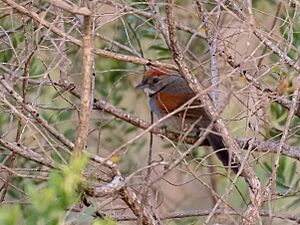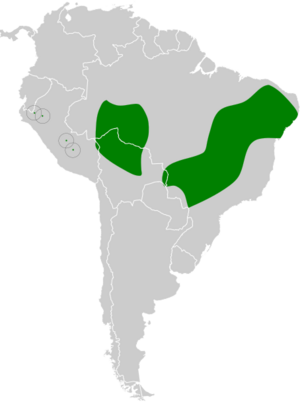Cinereous-breasted spinetail facts for kids
Quick facts for kids Cinereous-breasted spinetail |
|
|---|---|
 |
|
| Conservation status | |
| Scientific classification | |
| Genus: |
Synallaxis
|
| Species: |
hypospodia
|
 |
|
The cinereous-breasted spinetail (Synallaxis hypospodia) is a cool bird that belongs to the ovenbird family, called Furnariidae. You can find this bird in parts of Bolivia, Brazil, Paraguay, and Peru.
Contents
About the Cinereous-breasted Spinetail
What's in a Name?
The cinereous-breasted spinetail was once thought to be a type of Spix's spinetail. But now, scientists know they are actually two different, but closely related, species. This bird is also monotypic, which means it's the only species in its group.
What Does This Bird Look Like?
The cinereous-breasted spinetail is about 15 to 16 centimeters (6 inches) long. It weighs around 15 to 18 grams, which is about as much as three nickels. Both male and female birds look alike.
Their face is mostly gray-brown with a light gray stripe above their eye. The top of their head is dark gray-brown, and the back of their head and neck are a reddish-brown color. Their back and tail feathers are dark brown.
Their wings have reddish-brown feathers, and their flight feathers are dark brown with reddish edges. Their tail is a darker brown and has rounded tips.
The bird's chin and throat are mostly white. Their chest is brownish-gray, which is where the "cinereous" (meaning ash-colored) part of their name comes from. Their belly is whitish, and their sides are brownish.
Their eyes are reddish-brown. Their beak is black on top and silvery-gray on the bottom. Their legs and feet can be olive green or brownish-yellow. Young birds have a gray-brown head and more brownish-yellow underparts. Their throat patch is also not as clear as adult birds.
Where Do Cinereous-breasted Spinetails Live?
Bird Homes and Habitats
The cinereous-breasted spinetail lives in different areas, not all connected. One group lives in eastern Peru, northern and eastern Bolivia, and western Brazil. Another group lives in northeastern Brazil, stretching southwest into southeastern Bolivia and northeastern Paraguay. There have also been a few sightings in central Peru, but some of these might be mistaken identities.
These birds like open areas. They live in places like grasslands that get wet during certain seasons, scrublands, and savannahs. They especially like areas that are close to water. You can find them from sea level up to about 700 meters (2,300 feet) high.
How Do Cinereous-breasted Spinetails Behave?
Staying in One Place
The cinereous-breasted spinetail does not migrate. It stays in the same area all year long.
What Do They Eat?
Scientists don't know a lot about what these birds eat or how they find their food. They probably eat small insects and other tiny creatures. They pick these off leaves and small branches, usually staying about 1 to 2 meters (3 to 7 feet) above the ground. You will often see these birds in pairs.
Raising a Family
Right now, we don't know anything about how the cinereous-breasted spinetail builds nests or raises its young.
What Sounds Do They Make?
One way to describe their call is a "hurried and loud chatter." It sounds like "chéw, chew-chee-chee-chee-ee-ee-ee-ee-ee-eu," and it gets faster at the end. Another way to describe it is a "high, sharp 'tut-Drrrrrrruh'," with the last part sounding quick and going down in pitch.
Is This Bird Safe?
Conservation Status
The IUCN (International Union for Conservation of Nature) says the cinereous-breasted spinetail is a species of "Least Concern." This means they are not currently in danger of disappearing. They live across a large area, and even though we don't know their exact population size, it seems to be stable. There are no immediate threats to this bird. While it's not super well-known, it's considered common in many places.


